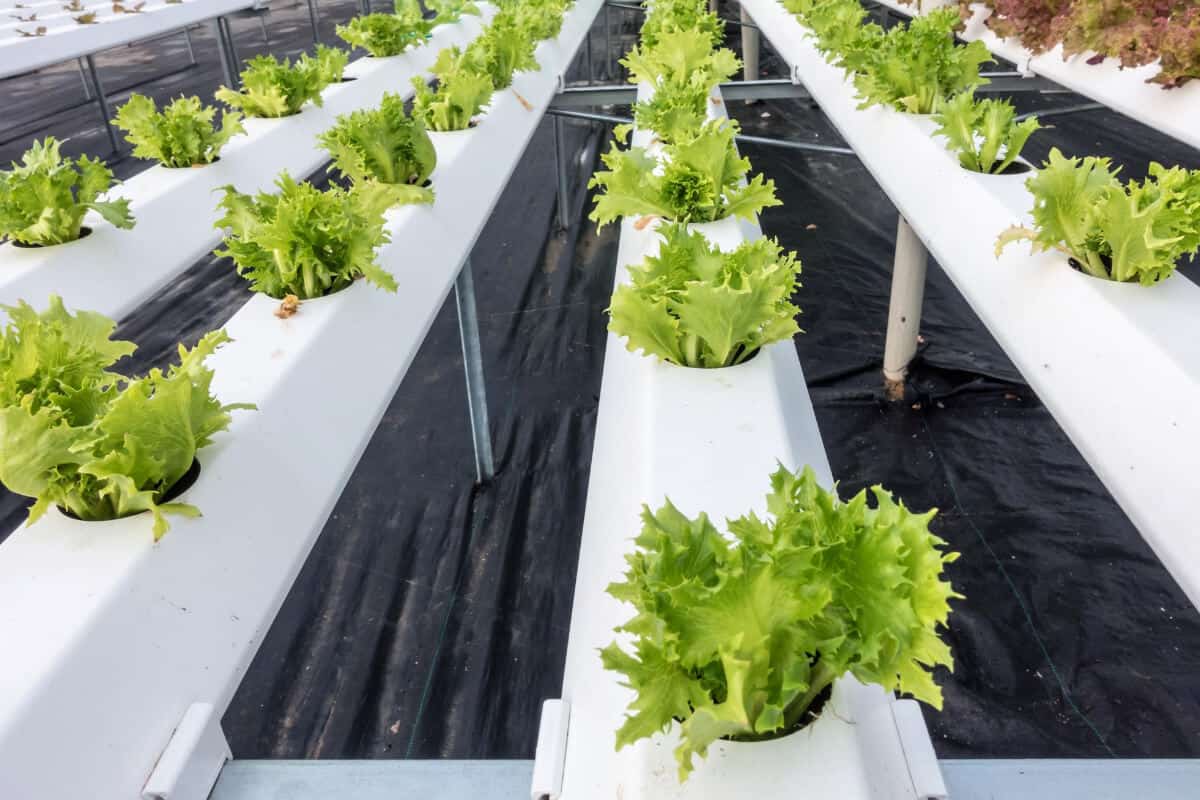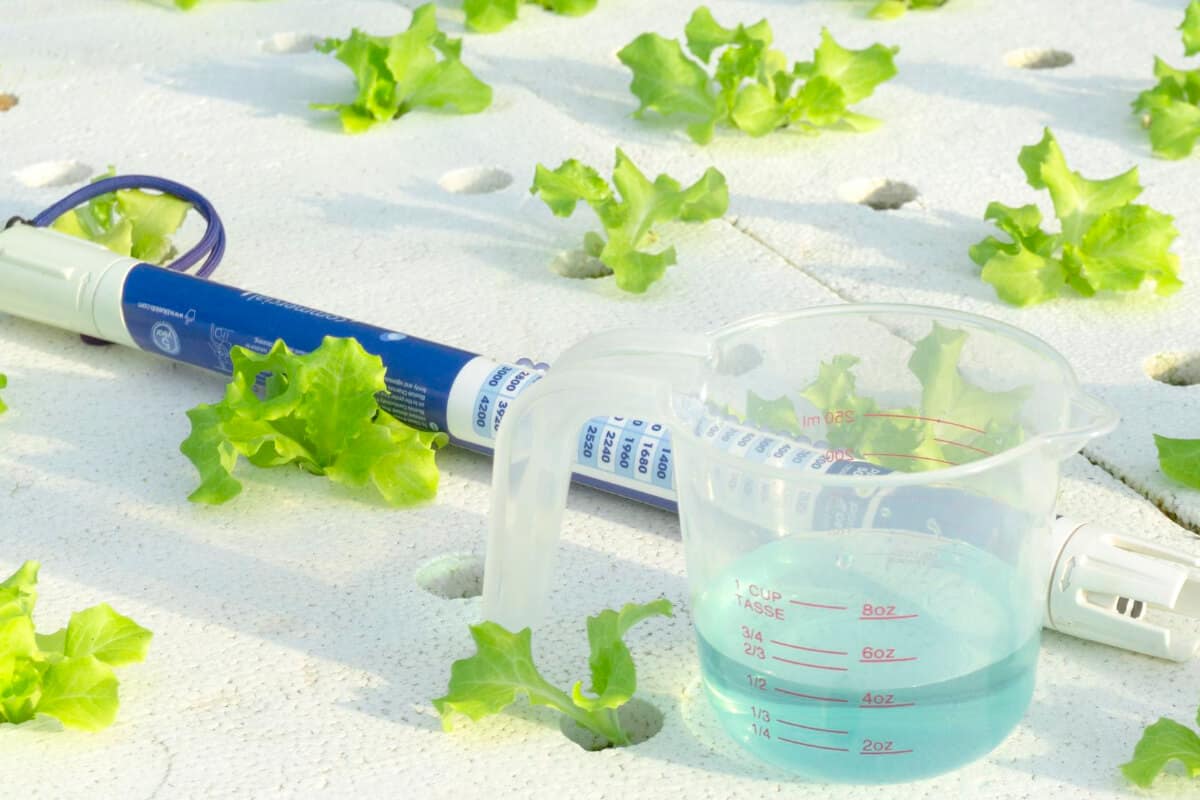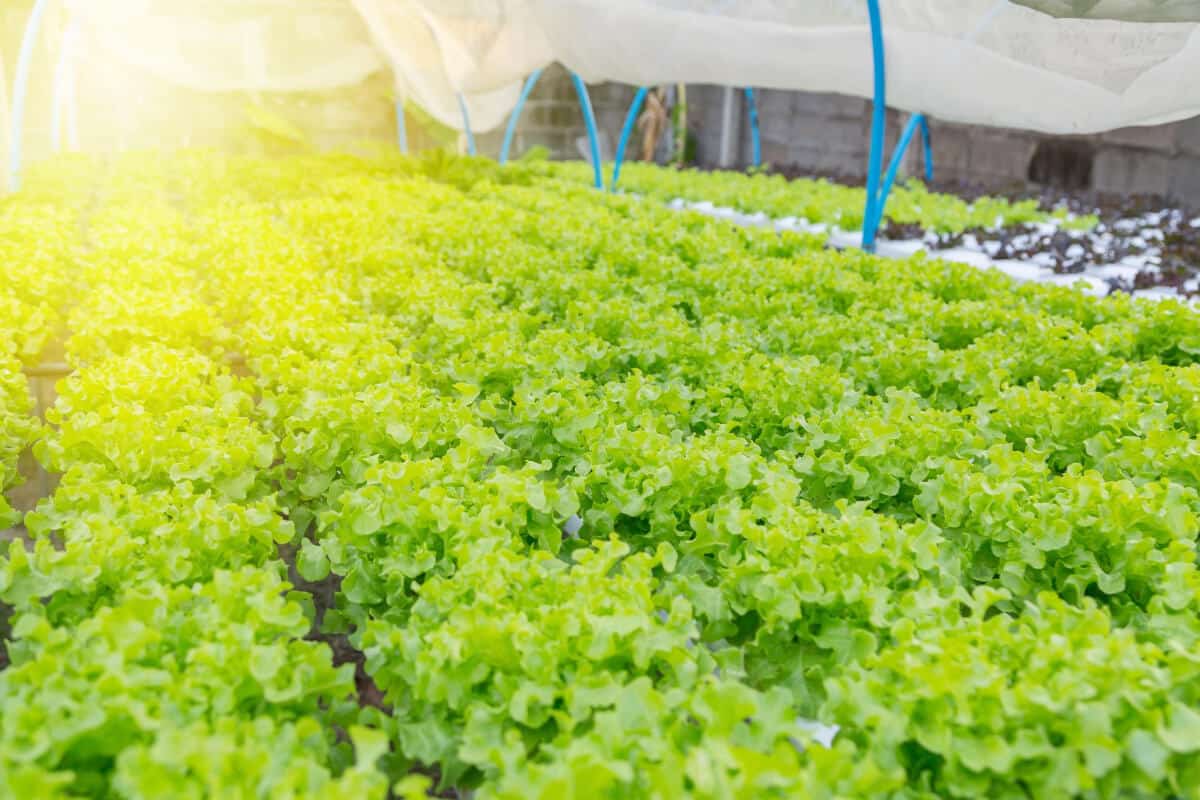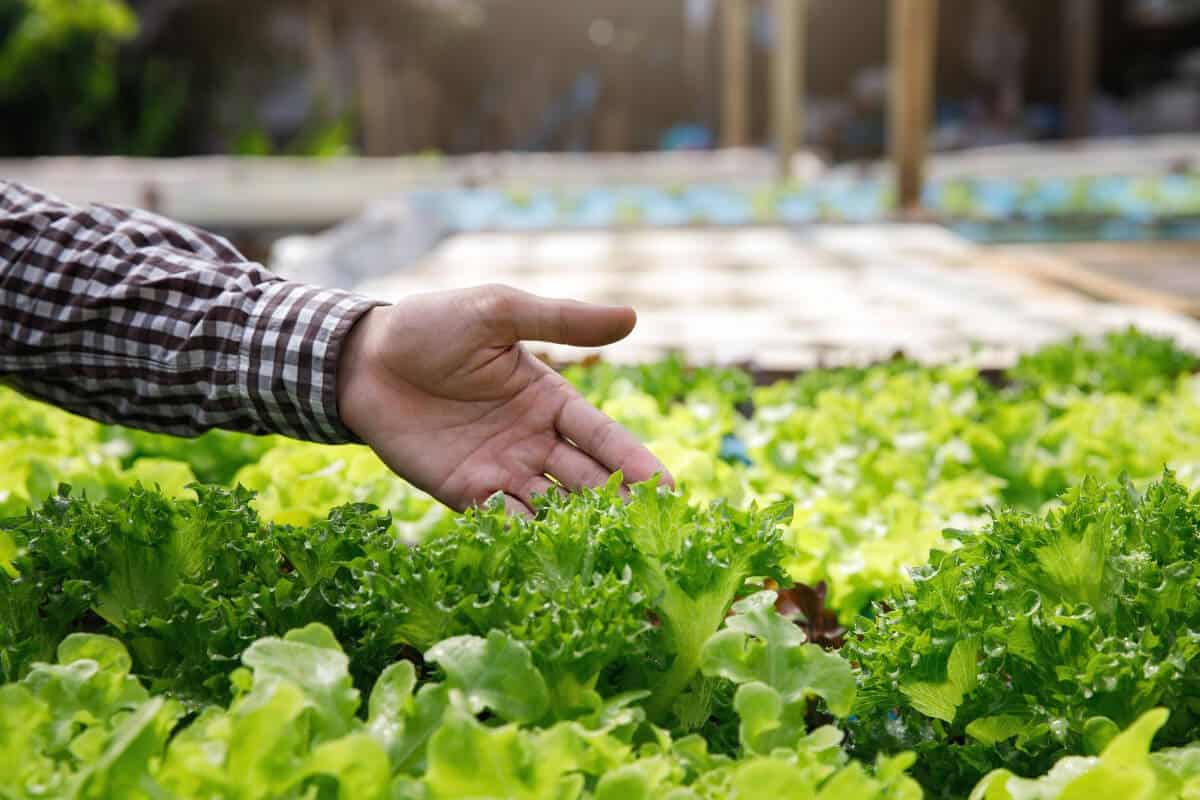Tired of lettuce-less lunches? Take control of your salad destiny and grow your own leafy greens! Say goodbye to wilted and sad store-bought lettuce forever.
For individuals without extensive land or optimal soil conditions, there are alternative methods for beginning a garden.
Hydroponics is an alternative soil-less method that produces faster-growing and healthier lettuce than your average lettuce that grows in the soil.
Growing lettuce is not as sophisticated as some may say it is. Growing hydroponic lettuce plants will only require some basic knowledge and application.
Don’t worry we will explain everything to you: everything you need to know about the optimal growth of your lettuce and how to start your own hydroponic lettuce garden.
- Related article: Easy Hydroponic Plants
Let’s dive in and get started!
Why Grow Hydroponic Lettuce?

Benefits of Growing Hydroponic Lettuce
- Growing lettuce in hydroponic gardens will only take up to 4 weeks for some varieties—it’s a faster-growing method compared to soil.
- Hydroponic lettuce systems doesn’t require a lot of space to cultivate so it is perfect for growing in small open spaces in your home.
- There are far fewer pests that will affect your harvest.
- Soil diseases are non-existent with this method.
- You will save a significant amount of water compared to farming in soil.
- You will save on the amounts of fertilizer needed as the plants directly absorb all the nutrients.
- You can grow lettuce all year round, even in winter, with a hydroponic environment.
Drawbacks of Growing Hydroponic Lettuce
- It’s tricky to understand the nutrient requirements at first, and it takes time to learn the right amounts and what types of hydroponic nutrients work best.
- Expect a higher electrical bill with all the equipment running.
- Daily maintenance and pruning are essential.
- The equipment is rather pricy.
Equipment Needed to Grow Hydroponic Lettuce

To mimic the initial environment that plants are accustomed to growing in will require an array of essential equipment.
The basic hydroponics equipment needed for growing lettuce in hydroponics are:
- Air pump – A device that pumps air, usually used to add oxygen to a hydroponic system.
- Air stone – A porous stone or ceramic disc used in an aquarium or hydroponic system that creates tiny bubbles when connected to an air pump.
- Filter – A tool used to eliminate particles from water by directing it through a mesh or other materials.
- Lighting – A type of device that is commonly used in hydroponic systems to provide light for plants. These devices can come in the form of fluorescent or LED lights.
- pH tester – A device used to measure the acidity or alkalinity of a liquid, typically represented by a numerical scale that ranges from 0 to 14 (0 indicating the most acidic and 14 indicating the most basic).
- Fan – An electrical device that facilitates air circulation and ventilation in hydroponic systems.
- Heater – An electric heater used to maintain the optimal temperature for growing plants in a hydroponic system.
- Pruning scissors – Specialized scissors designed specifically for pruning and trimming plants in order to promote healthy growth.
- Water piping – Pipes or tubing designed to transport water within a hydroponic system.
- Grow trays – Trays used to hold the plants and their containers in a hydroponic system.
- Plant containers – Necessary for growing lettuce in a hydroponic system. These containers can include pots, buckets, or other vessels that support the plant roots.
- Water reservoir – A container specifically made to store and supply water for hydroponic systems.
How to Grow Hydroponic Lettuce
Choose the Lettuce Variety to Grow
The kaleidoscope of lettuce options at the grocery store will make your imagination run wild with the endless possibilities of leafy greens.
The growth and yield rates of various types of lettuce exhibit differences.
Lettuces with denser leaves, such as the Iceberg Lettuce, require up to eight weeks to mature in a hydroponic system.
The optimal lettuce varieties for hydroponic cultivation are:
- Butterhead Lettuce – A variety of lettuce with ruffled leaves and a sweet, buttery taste. It is usually cultivated using hydroponic systems and harvested within a timeframe of 3-4 weeks.
- Romaine Lettuce – Also referred to as Cos lettuce, is a widely used type of lettuce that is crispy and has a sweet flavor. It has long leaves and can be harvested within 4 weeks.
- Little Gem Lettuce – A kind of lettuce that has a small head and a crispy texture. It typically has a slightly sweet and nutty flavor, with tender leaves.
- Lollo Lettuce – A type of lettuce characterized by its curly, frilly leaves and mild flavor. It is versatile and can be used in salads, sandwiches, and wraps.
Hydroponic systems are suitable for growing all types of lettuce. The choice of lettuce flavor and texture is up to personal preference.
Choose the Hydroponic Technique
Hydroponics is a younger methodology for cultivating vegetables. So far, it has developed 7 preferred techniques, and they all accommodate different types of grows and are best suited to certain plants.
The 7 hydroponic techniques that are commonly used by growers are:
- Deep Water Culture (DWC) – A technique that uses a reservoir to suspend the plant roots in the water while they receive nutrients and oxygen.
- Wicking – A passive hydroponic system that relies on capillary action to transport nutrient solution from a reservoir to the root zone.
- Nutrient Film Technique (NFT) – A form of hydroponics that involves cultivating plants in channels where a thin film of nutrient-rich water flows over their roots.
- Ebb and Flow – Also referred to as Flood and Deain, involves saturating the root zone with water enriched with nutrients and subsequently draining it into the reservoir.
- Kratky Method – A type of non-circulating hydroponic system that uses a sealed container instead of a pump to keep the roots submerged in a nutrient-rich solution.
- Aeroponics – A method where plants are suspended in air and their roots are sprayed with a fine mist made up of oxygen, nutrients, and water.
- Drip Systems – A type of recovery or non-recovery hydroponic system where each plant is connected to an individual nutrient reservoir by an irrigation line.
The Kratky method is the best-recommended technique to grow hydroponic lettuce. Other well-recommended techniques are the Nutrient Film Technique and the Ebb and Flow system.
Light and Temperature Conditions

The amount of light that lettuce needs to grow in a hydroponic system is dependent on what type of grow light is used as LED lights are stronger than a T5 fluorescent light.
The average amount of direct light that is recommended for growing lettuce in hydroponics is 12 hours of light per day.
Plants all have their own preferred air temperatures; some prefer the heat or hotter temperatures while others like the shade and cooler temperatures.
Lettuce grows best between 68-75°F in a hydroponic system.
Water and pH Levels
There are several means of obtaining water for your hydroponics. Water that has been sourced from a stream or from an underground spring will contain different minerals from water that is sourced from the tap.
Tap water may contain chemicals like chlorine which are used to make it clear. It is advisable to utilize water that is free from impurities.
It is recommended to test the quality of your water before starting a hydroponic garden if there are any doubts.
The optimal temperature for lettuce growth is 21°C, which is slightly warmer water.
Measuring the pH levels of water can determine its acidity or alkalinity. Utilizing a pH tester provides precise readings. Optimal growth for lettuce occurs in water with a pH level ranging from 5.5-6.
Growing Medium
Lettuce, as a seedling, will need to be planted in a growing medium as it replaces the natural purpose of soil.
Soil provides the support structure for seeds to be able to germinate and expand their rooting system before the seedling can spout above the soil.
In a hydroponic system, the roots of the seedling need some support. A growing medium provides the initial support a young seedling needs to grow its roots into the hydroponic system.
The best-growing mediums for lettuce are Rockwool and Phenolic Foam. However, some hydroponic growers’ opinions and mediums of choice may differ.
These are alternative popular options of growing mediums that can be used for lettuce:
- Coco Coir – Coco coir is a type of soil-less medium made from the husks of coconuts. It is popular in hydroponics as it holds water well, has excellent drainage and aeration, and has a neutral pH level.
- Jiffy Plugs – Jiffy plugs are discs made from peat moss that have been compressed into a disc shape. These are often utilized for initiating seed growth because of their excellent water retention and ease of transplantation into bigger containers.
- Clay Pellets – A type of small, round, hard pellet that varies in size. They are ideal for hydroponic systems as they retain moisture well and offer sufficient oxygen to the root system.
Nutrient Solution
There are several important aspects of hydroponics that need to be mastered for successful growth.
Giving your plants the correct amounts of nutrients in your water is one of the key factors of hydroponics that you can’t really afford to get wrong.
Plants generally need a variation in their diet as different nutrients support different features of the plant.
Lettuce has very green leaves and leafy greens need nitrogen. Aside from that and amongst other nutrients, calcium, potassium, and magnesium are the most crucial nutrients.
Hydroponic growers will generally use a well-balanced mix of nutrients to cover all the basic requirements that a plant will need.
That does work well, but some plants require higher nutrient levels and different stages in their life cycle.
Lettuce fertilizer high in nitrogen and potassium works best for growing hydroponic lettuce.
Lettuce needs to consume micronutrients such as boron, copper, iron, and manganese for its nutrition requirements.
Pollination
Pollination is the process of transferring pollen from one flower’s anthers to another flower’s stigma, which is often facilitated by insects like bees.
This causes the fertilizer flowers to turn into fruit or the plant will create seeds.
Lettuce is a leafy vegetable and doesn’t bear fruit, but it bears its own seeds and doesn’t require any pollination, making it an ideal plant to grow in hydroponic as it takes care of itself.
Pruning the Plants
Pruning is an essential part of hydroponics and the maintenance that needs to be up kept. Plants need to be pruned daily to prevent external pressure on their root system as excessive unwanted leaves take up nutrients.
Dead leaves that are not attended to will attract unwanted pests.
Lettuce generally doesn’t need to be pruned as its leaves are harvested, but any excessive dead leaves on your lettuce plants must be removed.
Propagating the Plants
Propagating lettuce can be done in more than one way in a hydroponic system.
To propagate lettuce, simply place 2-3 lettuce seeds in a growing medium and keep it moist. The seeds must be kept at 68°F with 12 hours of light provided.
The seedlings will soon sprout and take root in the growing medium.
Lettuce can also be grown from an old lettuce head. You will have to place the lettuce head in the water and wait for it to begin to show signs of rooting.
When rooting is prevalent, transplant the lettuce head into a growing medium and it will start to reproduce lettuce leaves after a few weeks.
Harvest the Lettuce
The method for harvesting lettuce varies and is determined by the type of lettuce being harvested.
Harvesting lettuce with the roots is a simple process. You just need to lift the entire head of lettuce from the container and rinse it thoroughly.
After washing it, put it on a drying rack away from direct sunlight.
Harvesting lettuce without the roots will require some care and scissors. Should you be harvesting Cos Lettuce, you can simply cut a few leaves off the lettuce plant.
It’s important to leave a few leaves on the plant as it will regrow more fresh lettuce leaves.
Troubleshooting Hydroponically Growing Lettuce

A common problem associated with growing lettuce in hydroponics is Tip Burn, which is caused by your roots being exposed to air. Raise the level of water in your water tank to rehydrate the exposed roots.
Lettuce is also prone to attacks from pests—aphids, thrips, whiteflies, and mites will all be a prevailing threat to your lettuce.
You can prevent pests from destroying your harvest by using pesticides and insecticides, or by placing Ladybugs on your lettuce leaves.
Common Growth Problems
Common growth problems that occur with hydroponic lettuce are:
- Fusarium Wilt – Fusarium Wilt is a fungus that grows better in hotter climates. It is generally carried by nematodes in the soil, but can also be carried on seeds.
- Dampening off – Dampening off is a fungus that rots the root of the stem of a plant and root tissue. It is caused by cool, wet conditions and seedlings are particularly vulnerable to this fungus.
- Incorrect water temperature – Hydroponic lettuce grows best at a water temperature of 20-25°C, and colder water temperatures will cause a stunt in lettuce growth.
- Plant leaf issues – Planting infected lettuce seedlings result in the leaves of the plant wilting and the plant will infect other healthy plants.
Common Pests
Indoor pests will always be a problem that you will have to prevent and if needed, eradicate immediately.
Lettuce has juicy green leaves that will attract many pests. Fortunately, indoor hydroponic lettuce will have fewer pests like snails, caterpillars, and moths, to worry about.
This doesn’t mean to say that you won’t have the risk of pests invading their crops.
There are some mean pests that always seem to find your plants, wherever you decide to grow them.
The following pests are commonly present in hydroponic systems:
- Aphids – A type of small insect with soft bodies that feed on plants by sucking sap from leaves and stems. They are found in a variety of colors such as green, yellow, brown, or black, and their feeding can result in discoloration and wilting of foliage.
- Whiteflies – Small insects that fly and are white in color. They feed on plant sap and produce a sticky substance that promotes the growth of sooty mold. They harm plants by extracting their juices and can transfer disease from one plant species to another.
- Mites – Small arachnids that consume plant tissue by piercing the surface of leaves with their mouthparts. Their feeding can lead to yellow spots on leaves and, if not controlled, they can also harm young seedlings.
- Thrips – A type of small, slender insect that typically feeds on various parts of plants such as flowers, buds, leaves, and fruits. They can transmit several diseases like Tomato Spotted Wilt Virus (TSWV) which causes fruit deformities and stunted growth in plants.
To avoid pests from infesting hydroponic lettuce, it is important to keep the outside out. Equipment should be sterilized and any material introduced to the growing area should be checked.
Pests can be eliminated through the use of insecticides such as insecticidal soap or eco-friendly pesticides. Introducing ladybugs and spider wasps into your grow area will eradicate pests too.
Common Diseases
Hydroponic lettuce can expect several diseases and you should know how to prevent them from killing your plants.
The moist conditions that hydroponics provide a potential breeding ground for fungus, one of the most common ones would be Downey Mildew.
It will cause the leaves of your lettuce plant to turn yellow and a grey fungus will appear on the undersides of your lettuce leaves.
The wet and overwatering nature of hydroponics encourages Downey Mildew to occur. To avoid having them from occurring on your leaves, ensure that there is adequate drainage for your plants.
Lettuce is also susceptible to Sclerotinia—this disease rots the stems of the lettuce and originally is a disease that is associated with soil. It is passed on to plants by pathogens.
Plants are generally affected by this disease after they have flowered.
Growing Hydroponic Lettuce Final Thoughts
Hydroponic lettuce is a sustainable and efficient way to grow fresh and nutritious produce year-round.
By optimizing the growing conditions and utilizing technology, hydroponic lettuce production can achieve high yields of healthy lettuce while using less water and space than traditional farming methods.
With the increasing demand for locally grown food, a hydroponic crop of lettuce is becoming a popular choice among urban farmers and consumers.
Additionally, by implementing sustainable practices and utilizing renewable energy sources, hydroponic lettuce production can contribute to a greener and cleaner environment!
To learn more about growing hydroponic plants, check these articles out:

